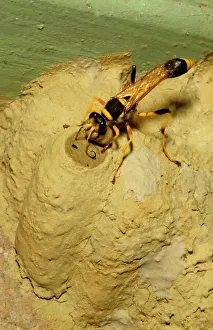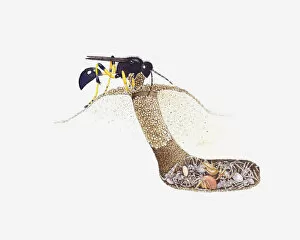Mud Dauber Collection
The mud dauber, a common wasp found in various parts of the world, is a fascinating creature with unique behaviors and nesting habits
All Professionally Made to Order for Quick Shipping
The mud dauber, a common wasp found in various parts of the world, is a fascinating creature with unique behaviors and nesting habits. In Central America's Costa Rica, specifically Dominical, one can witness the impressive sight of a mud dauber nest built on a lone twig. This solitary species constructs its nests by collecting mud and shaping it into cylindrical cells. The female mud dauber plays an essential role in ensuring the survival of her offspring. After laying one or more eggs inside each cell, she diligently hunts for spiders to provide as food for her larvae. The captured spiders are paralyzed but kept alive to ensure their freshness when consumed by the growing young ones. In Florida's sheltered locations during June, one might stumble upon nests of organ pipe mud daubers grouped together. These communal nests serve as protection against predators and adverse weather conditions. A cross-section illustration reveals the intricate structure of a mud dauber nest entrance where larvae feed on spiders hidden within underground chambers. It showcases nature's ingenuity at work. As we observe these industrious insects in action, we witness females meticulously closing completed cells that house their precious eggs and paralyzed spider provisions. They tirelessly add new cells to expand their nests further while ensuring an ample supply of food for their developing offspring. Once emerged from their cocoons, adult mud-daubers leave behind empty nests - remnants of their solitary existence before venturing out into the world independently. The opening of a nest cell unveils an astonishing sight: paralysed spiders neatly arranged as sustenance for hungry larvae awaiting hatching within each chamber. This gruesome yet necessary process highlights nature's delicate balance between life and death. Intriguingly enough, despite multiple images showcasing similar scenes throughout this caption journey – from building nests to adding cells – they all emphasize the importance placed on providing abundant nourishment through paralysed spiders for future generations' growth and development.











